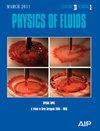Stability of low-pressure turbine boundary layers under variable Reynolds number and pressure gradient
IF 4.3
2区 工程技术
Q1 MECHANICS
引用次数: 0
Abstract
The free-stream turbulence induced transition occurring under typical low-pressure turbine flow conditions is investigated by comparing linear stability theory with wind tunnel measurements acquired over a flat plate subjected to high turbulence intensity. The analysis was carried out, accounting for three different Reynolds numbers and four different adverse pressure gradients. First, a non-similarity-based boundary layer (BL) solver was used to compute base flows and validated against pressure taps and particle image velocimetry (PIV) measurements. Successively, the optimal disturbances and their spatial transient growth were calculated by coupling classical linear stability theory and a direct-adjoint optimization procedure on all flow conditions considered. Linear stability results were compared with experimental particle image velocimetry measurements on both wall-normal and wall-parallel planes. Finally, the sensitivity of the disturbance spatial transient growth to the spanwise wavenumber of perturbations, the receptivity position, and the location where disturbance energy is maximized were investigated via the built numerical model. Overall, the optimal perturbations computed by linear stability theory show good agreement with the streaky structures surveyed in experiments. Interestingly, the energy growth of disturbances was found to be maximum for all the flow conditions examined, when perturbations entered the boundary layer close to the position where minimum pressure occurs.雷诺数和压力梯度可变情况下低压涡轮边界层的稳定性
通过将线性稳定性理论与在高湍流强度下对平板进行的风洞测量结果进行比较,研究了在典型的低压涡轮流动条件下发生的自由流湍流诱导转变。分析采用了三种不同的雷诺数和四种不同的不利压力梯度。首先,使用基于非相似性的边界层(BL)求解器计算基本流,并根据压力抽头和粒子图像测速(PIV)测量结果进行验证。随后,通过耦合经典线性稳定性理论和对所有流动条件的直接联合优化程序,计算了最佳扰动及其空间瞬态增长。线性稳定性结果与实验粒子图像测速仪在壁面法线和壁面平行平面上的测量结果进行了比较。最后,通过建立的数值模型研究了扰动空间瞬态增长对扰动的跨度波数、接收位置和扰动能量最大化位置的敏感性。总体而言,线性稳定性理论计算出的最佳扰动与实验中调查到的条纹结构显示出良好的一致性。有趣的是,在所研究的所有流动条件下,当扰动进入边界层靠近出现最小压力的位置时,扰动的能量增长都是最大的。
本文章由计算机程序翻译,如有差异,请以英文原文为准。
求助全文
约1分钟内获得全文
求助全文
来源期刊

Physics of Fluids
物理-力学
CiteScore
6.50
自引率
41.30%
发文量
2063
审稿时长
2.6 months
期刊介绍:
Physics of Fluids (PoF) is a preeminent journal devoted to publishing original theoretical, computational, and experimental contributions to the understanding of the dynamics of gases, liquids, and complex or multiphase fluids. Topics published in PoF are diverse and reflect the most important subjects in fluid dynamics, including, but not limited to:
-Acoustics
-Aerospace and aeronautical flow
-Astrophysical flow
-Biofluid mechanics
-Cavitation and cavitating flows
-Combustion flows
-Complex fluids
-Compressible flow
-Computational fluid dynamics
-Contact lines
-Continuum mechanics
-Convection
-Cryogenic flow
-Droplets
-Electrical and magnetic effects in fluid flow
-Foam, bubble, and film mechanics
-Flow control
-Flow instability and transition
-Flow orientation and anisotropy
-Flows with other transport phenomena
-Flows with complex boundary conditions
-Flow visualization
-Fluid mechanics
-Fluid physical properties
-Fluid–structure interactions
-Free surface flows
-Geophysical flow
-Interfacial flow
-Knudsen flow
-Laminar flow
-Liquid crystals
-Mathematics of fluids
-Micro- and nanofluid mechanics
-Mixing
-Molecular theory
-Nanofluidics
-Particulate, multiphase, and granular flow
-Processing flows
-Relativistic fluid mechanics
-Rotating flows
-Shock wave phenomena
-Soft matter
-Stratified flows
-Supercritical fluids
-Superfluidity
-Thermodynamics of flow systems
-Transonic flow
-Turbulent flow
-Viscous and non-Newtonian flow
-Viscoelasticity
-Vortex dynamics
-Waves
 求助内容:
求助内容: 应助结果提醒方式:
应助结果提醒方式:


